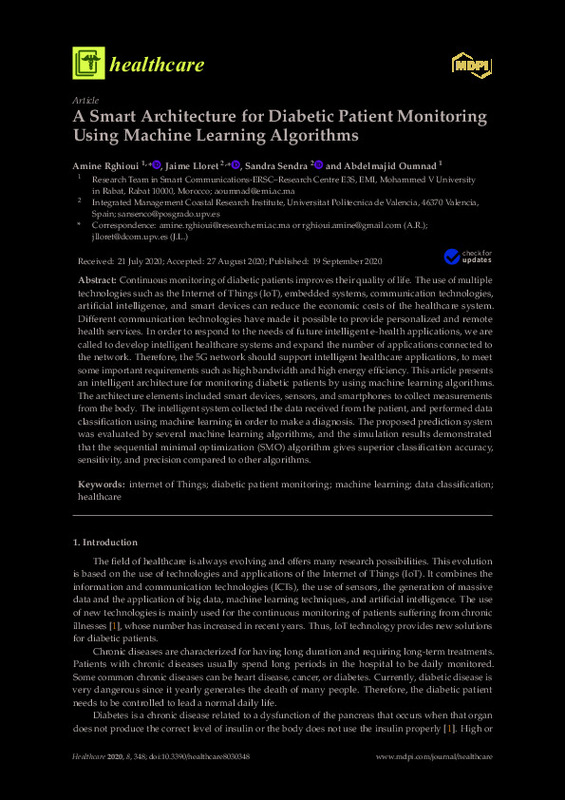JavaScript is disabled for your browser. Some features of this site may not work without it.
Buscar en RiuNet
Listar
Mi cuenta
Estadísticas
Ayuda RiuNet
Admin. UPV
A Smart Architecture for Diabetic Patient Monitoring Using Machine Learning Algorithms
Mostrar el registro sencillo del ítem
Ficheros en el ítem
| dc.contributor.author | Rghioui, Amine
|
es_ES |
| dc.contributor.author | Lloret, Jaime
|
es_ES |
| dc.contributor.author | Sendra, Sandra
|
es_ES |
| dc.contributor.author | Oumnad, Abdelmajid
|
es_ES |
| dc.date.accessioned | 2022-10-11T18:04:55Z | |
| dc.date.available | 2022-10-11T18:04:55Z | |
| dc.date.issued | 2020-09-19 | es_ES |
| dc.identifier.uri | http://hdl.handle.net/10251/187520 | |
| dc.description.abstract | [EN] Continuous monitoring of diabetic patients improves their quality of life. The use of multiple technologies such as the Internet of Things (IoT), embedded systems, communication technologies, artificial intelligence, and smart devices can reduce the economic costs of the healthcare system. Different communication technologies have made it possible to provide personalized and remote health services. In order to respond to the needs of future intelligent e-health applications, we are called to develop intelligent healthcare systems and expand the number of applications connected to the network. Therefore, the 5G network should support intelligent healthcare applications, to meet some important requirements such as high bandwidth and high energy efficiency. This article presents an intelligent architecture for monitoring diabetic patients by using machine learning algorithms. The architecture elements included smart devices, sensors, and smartphones to collect measurements from the body. The intelligent system collected the data received from the patient, and performed data classification using machine learning in order to make a diagnosis. The proposed prediction system was evaluated by several machine learning algorithms, and the simulation results demonstrated that the sequential minimal optimization (SMO) algorithm gives superior classification accuracy, sensitivity, and precision compared to other algorithms. | es_ES |
| dc.language | Inglés | es_ES |
| dc.publisher | MDPI AG | es_ES |
| dc.relation.ispartof | Healthcare | es_ES |
| dc.rights | Reconocimiento (by) | es_ES |
| dc.subject | Internet of Things | es_ES |
| dc.subject | Diabetic patient monitoring | es_ES |
| dc.subject | Machine learning | es_ES |
| dc.subject | Data classification | es_ES |
| dc.subject | Healthcare | es_ES |
| dc.subject.classification | INGENIERIA TELEMATICA | es_ES |
| dc.title | A Smart Architecture for Diabetic Patient Monitoring Using Machine Learning Algorithms | es_ES |
| dc.type | Artículo | es_ES |
| dc.identifier.doi | 10.3390/healthcare8030348 | es_ES |
| dc.rights.accessRights | Abierto | es_ES |
| dc.contributor.affiliation | Universitat Politècnica de València. Departamento de Comunicaciones - Departament de Comunicacions | es_ES |
| dc.description.bibliographicCitation | Rghioui, A.; Lloret, J.; Sendra, S.; Oumnad, A. (2020). A Smart Architecture for Diabetic Patient Monitoring Using Machine Learning Algorithms. Healthcare. 8(3):1-16. https://doi.org/10.3390/healthcare8030348 | es_ES |
| dc.description.accrualMethod | S | es_ES |
| dc.relation.publisherversion | https://doi.org/10.3390/healthcare8030348 | es_ES |
| dc.description.upvformatpinicio | 1 | es_ES |
| dc.description.upvformatpfin | 16 | es_ES |
| dc.type.version | info:eu-repo/semantics/publishedVersion | es_ES |
| dc.description.volume | 8 | es_ES |
| dc.description.issue | 3 | es_ES |
| dc.identifier.eissn | 2227-9032 | es_ES |
| dc.identifier.pmid | 32961757 | es_ES |
| dc.identifier.pmcid | PMC7551629 | es_ES |
| dc.relation.pasarela | S\472805 | es_ES |








